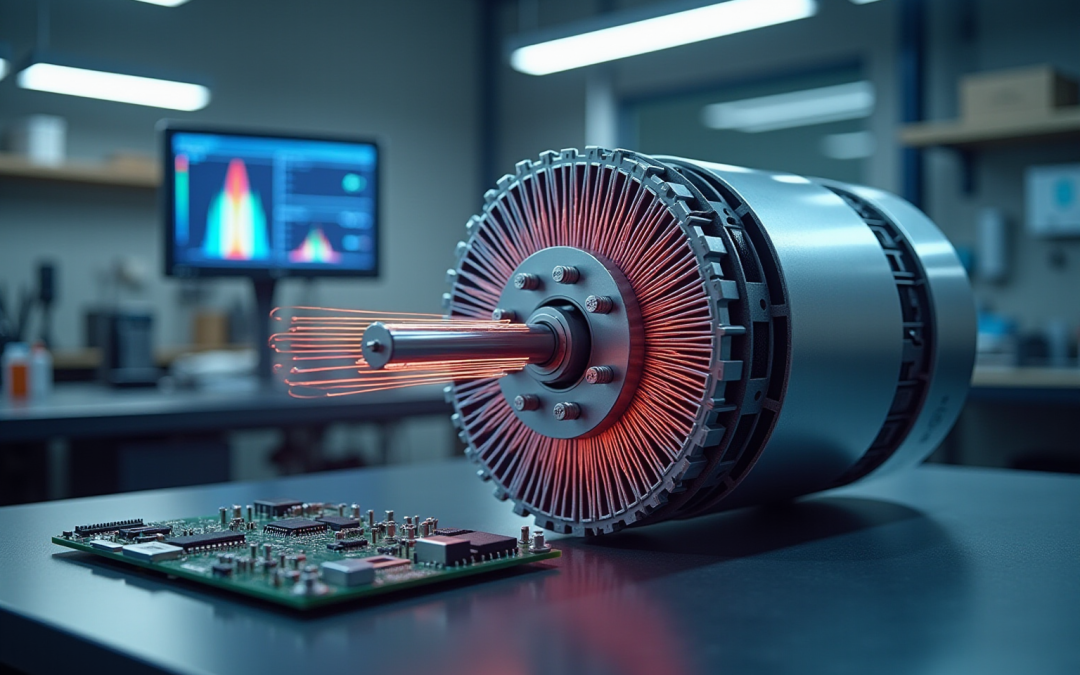Overview
The d-axis represents a pivotal concept in electronics engineering, particularly for synchronous devices, as it aligns with the rotor’s magnetic field and plays a significant role in torque production and reactive power management. This article underscores its importance through illustrative examples, such as the d-q transformation in motor control and its applications in electric vehicles and renewable energy systems. By emphasizing the understanding of the d-axis, we highlight its critical contribution to enhancing efficiency and performance in contemporary electronic applications.
Introduction
In the realm of electronics engineering, the d-axis emerges as a pivotal concept, particularly in the analysis and control of synchronous machines. This direct axis aligns with the rotor’s magnetic field, influencing everything from torque production to reactive power management. As industries increasingly rely on permanent magnet synchronous motors (PMSMs) for applications ranging from electric vehicles to renewable energy systems, mastering the intricacies of the d-axis becomes essential for engineers.
The d-axis not only simplifies the complex dynamics of three-phase systems through the d-q transformation but also plays a crucial role in optimizing machine performance and efficiency. By delving into the characteristics, historical development, and modern applications of the d-axis, one can uncover its significant impact on the future of electrical machines and their capabilities in a rapidly evolving technological landscape.
Define d-Axis in Electronics Engineering
The direct axis stands as a fundamental concept in electronics engineering, particularly in the analysis of . Defined as the axis that aligns with the magnetic field of the rotor, it plays a crucial role in understanding machine performance. In (PMSMs), the with the magnetic field generated by the permanent magnets, while the quadrature axis is positioned at a right angle to it. This alignment is essential for and reactive power within these systems.
, denoted as X_d, is defined as the sum of leakage reactance X_l and armature reactance X_a, further illustrating the electrical characteristics associated with the d-axis. Practical applications of this concept are evident in the modeling and enhancement of electric devices, particularly in (EVs). A case study focusing on the integration of machine design and wireless power transfer (WPT) systems demonstrated the effectiveness of a closed-loop model that optimized the performance of electric machines. This comprehensive approach underscores the significance of the d-dimension in achieving effective functionality across various power conditions.
As noted by N.P., this work posits that understanding the is critical for operation in field weakening with a broad constant power range. This insight emphasizes the in of synchronous devices. A thorough comprehension of the d-axis is imperative for engineers engaged with synchronous devices, as it directly influences torque production and the overall effectiveness of the system. By mastering this concept, engineers can of advanced electrical devices, paving the way for innovative solutions within the electronics industry.
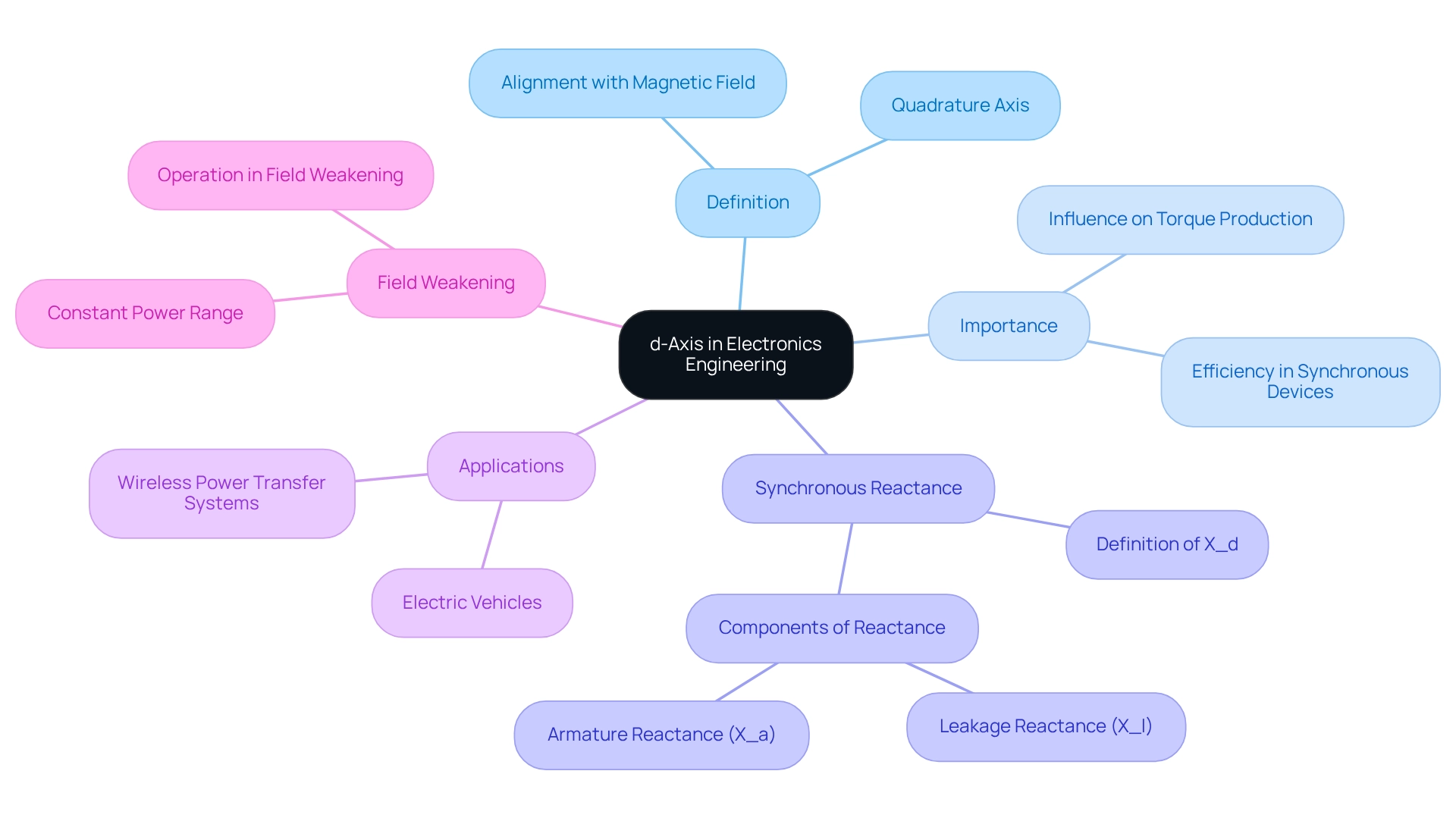
Contextualize the d-Axis in Electronics Engineering
The d-axis is integral to the functionality of various electrical devices, notably and generators. This component is crucial in the , a mathematical method that simplifies the analysis of three-phase systems by converting them into a two-axis framework. Such a transformation is vital in (PMSMs), where the direct current regulates , and the quadrature current manages .
For example, a steady-state engine speed of 3000 RPM exemplifies performance related to the d-axis. , including the friction coefficient and moment of inertia, is essential for optimizing performance and efficiency. A case study titled “” reveals that inaccuracies in these parameters can result in instability and diminished efficiency, highlighting the necessity of precise identification techniques in practical applications. The study underscores that accurate parameter identification is critical for effective operation.
Furthermore, Fengyuan Yin identifies that the RL framework comprises two regulation loops: the external loop employs a PI controller to adjust speed, while the internal loop utilizes an RL agent to modify the d-axis and Q-axis currents.
For engineers involved in motor regulation, renewable energy systems, and , an in-depth understanding of the d-axis is indispensable for efficient and the development of innovative solutions.
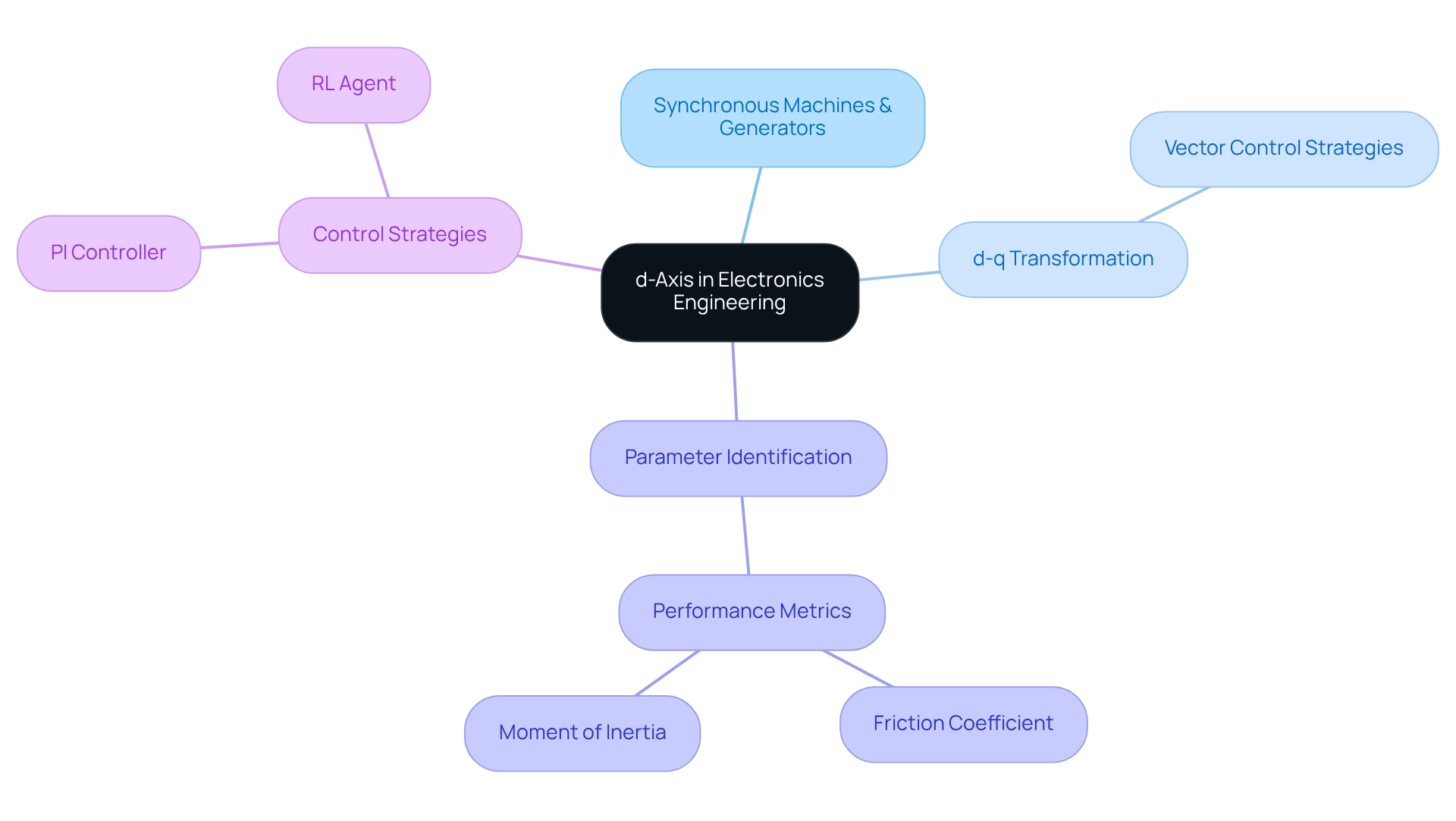
Trace the Origin and Development of d-Axis
The necessity to examine and manage alternating current (AC) systems more efficiently has led to the emergence of the d-axis concept. Early electrical engineers recognized that the complex interactions within three-phase systems could be simplified through a two-axis representation. This insight culminated in the development of the d-q transformation, which was formalized in the mid-20th century. As advanced, particularly with the introduction of digital regulation systems, the d-axis gained significance in the design and operation of . Today, it stands as a cornerstone of , enabling precise manipulation of equipment performance.
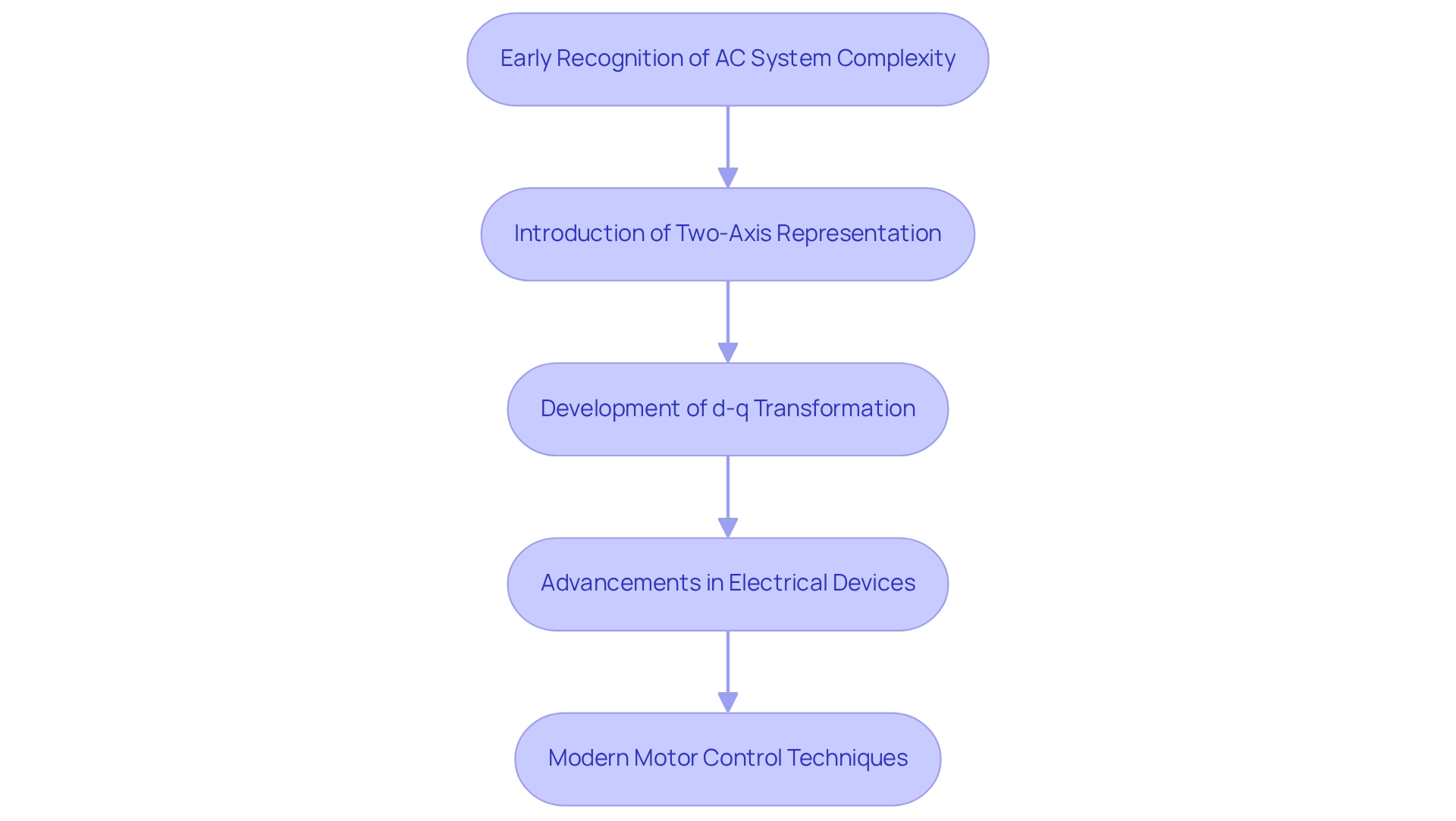
Identify Key Characteristics of d-Axis
The is defined by its alignment with the rotor’s magnetic field, playing a crucial role in managing reactive power and affecting . The current along this axis is vital for creating the magnetic field intensity, which is essential for optimal equipment performance. Notably, the inductance along the direct axis (denoted as Ld) is typically higher than that of the quadrature axis (Lq), significantly influencing the machine’s performance under dynamic conditions.
For instance, advancements in (PMSM) management techniques have demonstrated that can , thereby boosting overall efficiency. A recent study on model-free synergetic management of PMSMs revealed that this approach effectively mitigates performance degradation caused by parametric uncertainties and inverter nonlinearity, showcasing robust performance without output chattering.
Furthermore, the has positively impacted over 2 million individuals, underscoring the broader importance of progress in axis management techniques within the sector. Understanding these characteristics is crucial for engineers developing management systems for , as they directly affect efficiency and responsiveness in applications such as electric vehicles, where precise regulation of for delivering . Additionally, the magnetization property is assessed concerning the total magnetizing current, further highlighting the significance of managing the d-axis in synchronous machines.
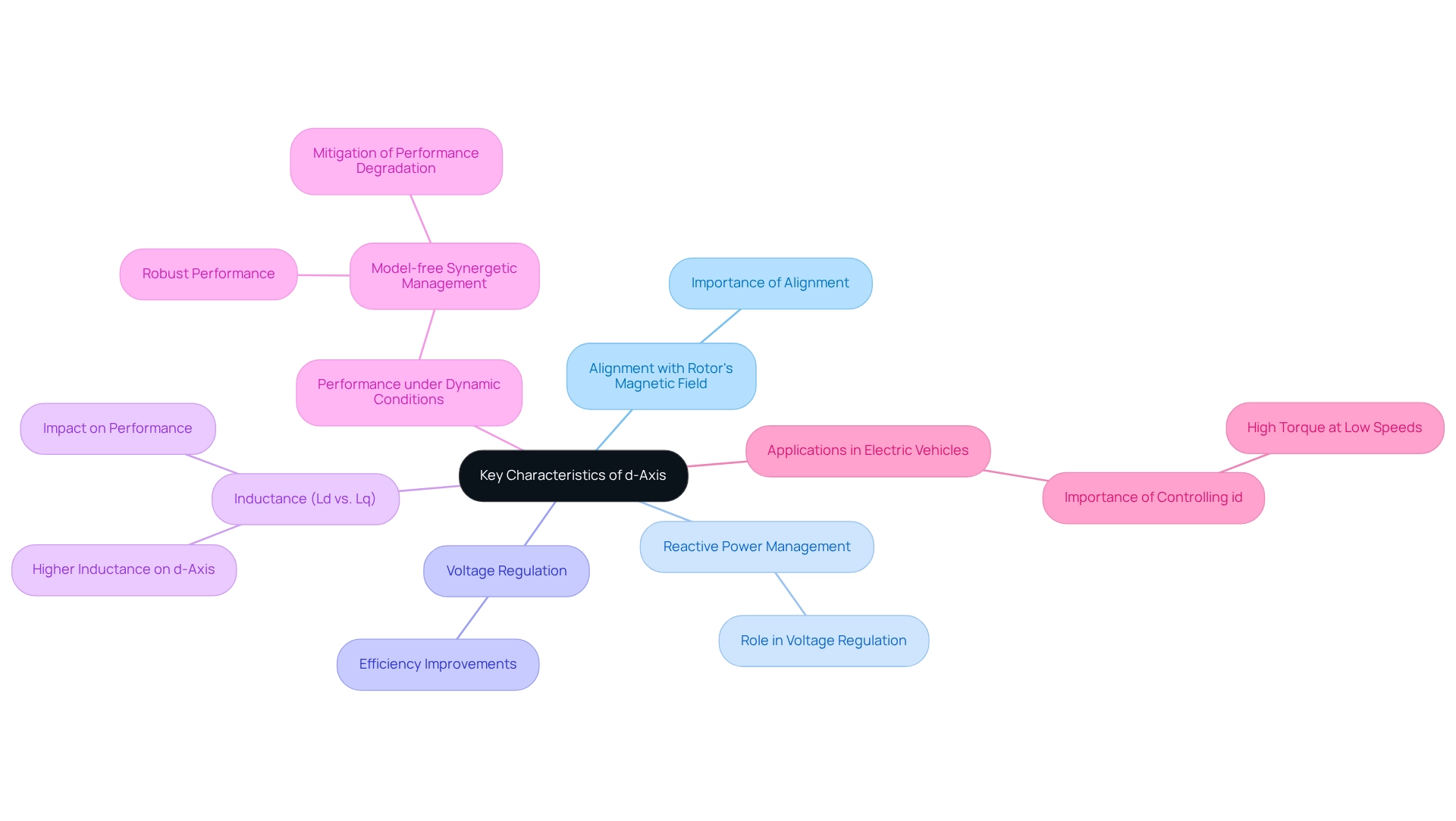
Applications of d-Axis in Modern Electronics
The plays a crucial role in contemporary electronic systems, particularly in the regulation of (PMSMs) employed in , robotics, and . By adjusting the , engineers can optimize performance, enhance efficiency, and improve torque response. For instance, in electric vehicles, the directional axis is essential for efficient operation, facilitating high effectiveness and reliability—attributes necessary for meeting the demands of modern transportation. An evaluation of electrical drive systems for electric vehicle applications underscores the significance of , illustrating how the d-axis contributes to these critical performance metrics.
In , such as wind turbines, the direct axis enables the regulation of reactive power flow, which is vital for grid stability. A case study on hybrid solar-wind energy systems reveals that incorporating axis management with a (DFIG) can significantly enhance energy production. This integration exemplifies the adaptability of the methodology in improving operational efficiency, particularly in systems that combine solar and wind energy. Moreover, the application of this method extends to robotics and industrial automation, where it is instrumental in enhancing the accuracy and responsiveness of . Real-world examples, such as the implementation of axis strategies in robotic arms and automated assembly lines, demonstrate their effectiveness in achieving high-performance outcomes. Insights from experts like Yee-Pien Yang, Jia-Yuan Liang, and Xian-Yee Xing, who assert that the optimal current waveform resembling the back electromagnetic force boosts output torque and efficiency, further highlight the d-axis’s importance in these applications.
As the demand for efficient and reliable electric machines continues to grow, understanding and leveraging the direct axis concept becomes increasingly vital. The integration of that utilize the d-axis can lead to substantial enhancements in power density and overall system performance, underscoring its significance in the advancement of modern electronic applications.
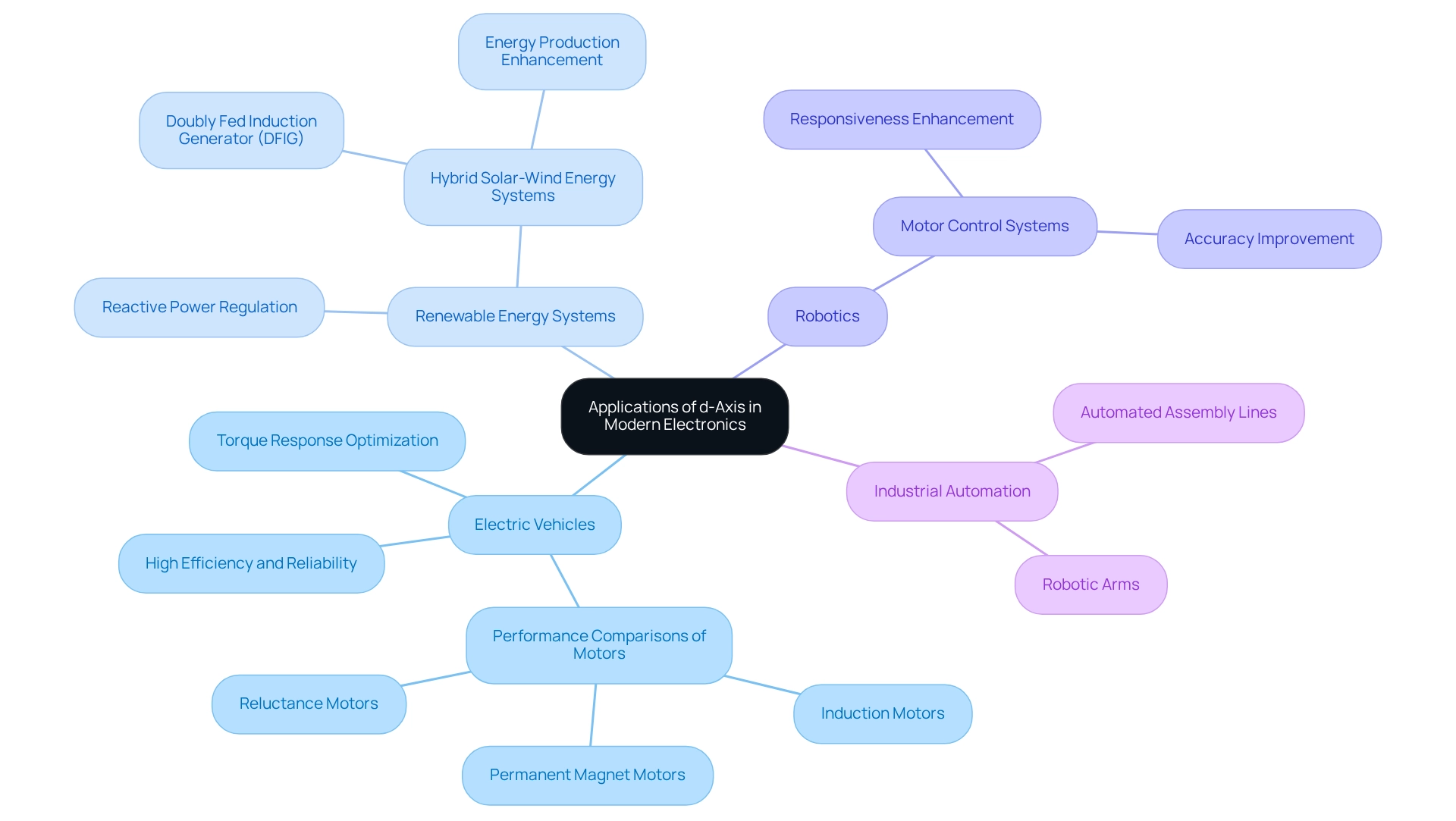
Conclusion
The d-axis stands as a cornerstone of electronics engineering, particularly in the operation and control of synchronous machines. Its alignment with the rotor’s magnetic field provides a clearer understanding of torque production and reactive power management—elements critical for optimizing the performance of permanent magnet synchronous motors (PMSMs). By employing the d-q transformation, engineers can simplify the complexities inherent in three-phase systems, facilitating enhanced control strategies vital for applications ranging from electric vehicles to renewable energy systems.
The article illustrates that the historical development of the d-axis has significantly influenced modern motor control techniques. This evolution underscores the necessity for engineers to master the d-axis to innovate and improve the functionality of electrical machines. The integration of precise d-axis management not only boosts efficiency but also enhances system responsiveness, which is essential in dynamic applications such as robotics and industrial automation.
In conclusion, as industries advance towards more efficient and reliable electric machines, the significance of the d-axis cannot be overstated. Understanding its characteristics and applications is crucial for engineers committed to pushing the boundaries of technology in electronics. By leveraging the potential of the d-axis, the future of electrical machines appears promising, paving the way for innovations that will shape the landscape of energy and automation in the years to come.
Frequently Asked Questions
What is the direct axis in electronics engineering?
The direct axis is a fundamental concept that aligns with the magnetic field of the rotor in synchronous devices, crucial for understanding machine performance.
How does the direct axis relate to permanent magnet synchronous motors (PMSMs)?
In PMSMs, the direct axis aligns with the magnetic field generated by the permanent magnets, while the quadrature axis is positioned at a right angle to it, which is essential for analyzing torque and reactive power production.
What is synchronous reactance and how is it related to the d-axis?
Synchronous reactance, denoted as X_d, is the sum of leakage reactance X_l and armature reactance X_a, illustrating the electrical characteristics associated with the d-axis.
What are the practical applications of the d-axis concept?
The d-axis concept is applied in modeling and enhancing electric devices, particularly in electric vehicles (EVs), and is demonstrated through case studies such as the integration of machine design and wireless power transfer (WPT) systems.
Why is understanding the displacement axis important for field weakening?
Understanding the displacement axis is critical for operation in field weakening with a broad constant power range, enhancing the efficiency of synchronous devices.
How does the d-q transformation relate to the d-axis?
The d-q transformation simplifies the analysis of three-phase systems into a two-axis framework, which is vital for vector control strategies in PMSMs, where the direct current regulates magnetic field intensity and the quadrature current manages torque generation.
What factors are important for optimizing performance related to the d-axis?
Accurate identification of parameters such as the friction coefficient and moment of inertia is essential for optimizing performance and efficiency.
What is the RL framework in the context of the d-axis?
The RL framework consists of two regulation loops: an external loop that uses a PI controller to adjust speed, and an internal loop that employs an RL agent to modify the d-axis and Q-axis currents.
Why is an understanding of the d-axis crucial for engineers?
An in-depth understanding of the d-axis is indispensable for engineers involved in motor regulation, renewable energy systems, and electric vehicles, as it aids in efficient power management and the development of innovative solutions.

